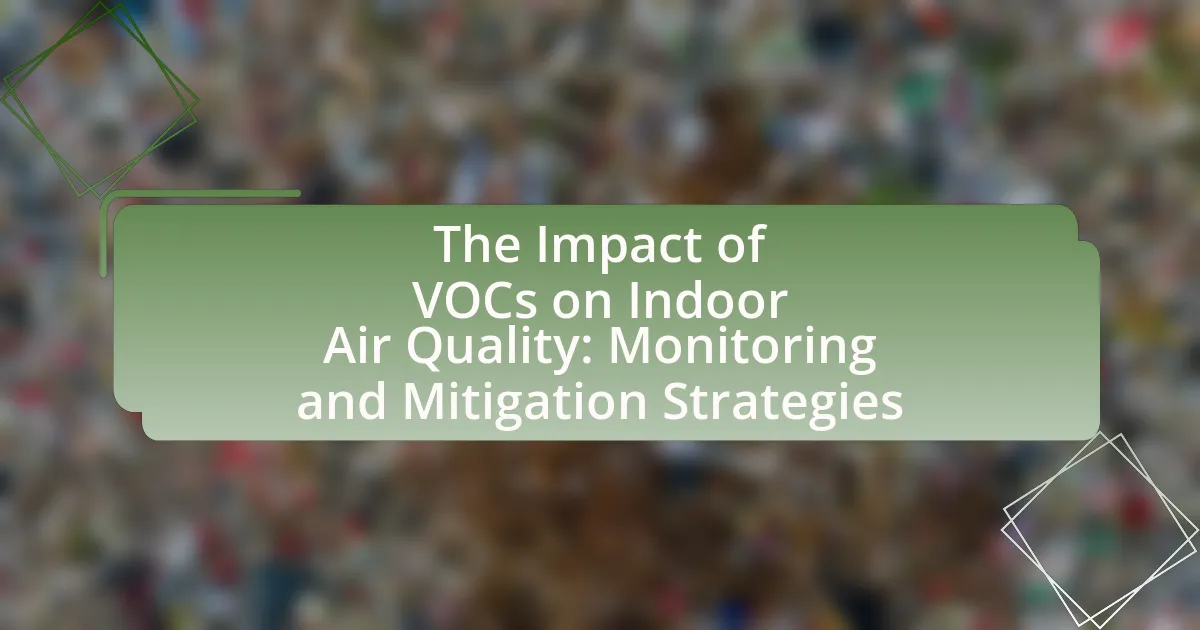Volatile organic compounds (VOCs) are organic chemicals that significantly impact indoor air quality, contributing to various health issues such as respiratory problems, headaches, and long-term damage to organs. This article examines the sources of VOCs commonly found indoors, including household products and building materials, and discusses their short-term and long-term health effects. It also explores effective monitoring methods, such as electronic sensors and passive sampling, as well as mitigation strategies like improving ventilation and using low-VOC products. By understanding the implications of VOCs and implementing recommended practices, individuals can enhance indoor air quality and reduce health risks associated with these harmful compounds.
What are VOCs and why are they significant for indoor air quality?

VOCs, or volatile organic compounds, are organic chemicals that have a high vapor pressure at room temperature, leading to significant evaporation into the air. They are significant for indoor air quality because they can contribute to various health issues, including respiratory problems, headaches, and eye irritation, as well as long-term effects like liver and kidney damage. Studies indicate that indoor concentrations of VOCs can be significantly higher than outdoor levels, often due to emissions from household products such as paints, cleaning agents, and building materials. For instance, the U.S. Environmental Protection Agency (EPA) has identified VOCs as a major contributor to indoor air pollution, emphasizing the need for monitoring and mitigation strategies to ensure healthier indoor environments.
How do VOCs affect human health?
VOCs, or volatile organic compounds, adversely affect human health by causing a range of symptoms and health issues. Exposure to VOCs can lead to respiratory problems, headaches, dizziness, and irritation of the eyes, nose, and throat. Long-term exposure is associated with more severe health effects, including damage to the liver, kidneys, and central nervous system, as well as an increased risk of cancer. According to the U.S. Environmental Protection Agency, certain VOCs, such as benzene and formaldehyde, are known carcinogens, highlighting the significant health risks posed by these compounds in indoor environments.
What are the short-term health effects of VOC exposure?
Short-term health effects of VOC exposure include headaches, dizziness, respiratory issues, and irritation of the eyes, nose, and throat. These symptoms arise due to the inhalation of volatile organic compounds, which can lead to acute health reactions. Studies have shown that exposure to high levels of VOCs can result in significant discomfort and health risks, particularly in poorly ventilated indoor environments. For instance, the U.S. Environmental Protection Agency (EPA) highlights that short-term exposure can exacerbate asthma symptoms and lead to allergic reactions.
What are the long-term health risks associated with VOCs?
Long-term exposure to volatile organic compounds (VOCs) can lead to serious health risks, including respiratory issues, neurological damage, and increased risk of cancer. Studies have shown that prolonged inhalation of VOCs can result in chronic respiratory diseases, such as asthma and chronic obstructive pulmonary disease (COPD), due to their irritant effects on the airways. Additionally, research indicates that certain VOCs, like benzene and formaldehyde, are classified as carcinogens, which means they can contribute to the development of cancer over time. Furthermore, neurological effects, including cognitive impairment and mood disorders, have been linked to long-term exposure to VOCs, as evidenced by findings from the National Institute of Environmental Health Sciences.
What sources of VOCs are commonly found indoors?
Common sources of VOCs found indoors include paints, varnishes, cleaning products, air fresheners, and building materials such as adhesives and carpets. These products release volatile organic compounds into the air, contributing to indoor air pollution. For instance, according to the U.S. Environmental Protection Agency, paints and solvents can emit high levels of VOCs, which can lead to health issues and decreased air quality.
How do household products contribute to VOC levels?
Household products contribute to VOC levels primarily through the release of volatile organic compounds during their use and storage. Common items such as paints, cleaning agents, air fresheners, and personal care products often contain solvents and chemicals that evaporate easily at room temperature, leading to increased indoor air pollution. For instance, studies indicate that indoor air can contain VOC concentrations up to ten times higher than outdoor air, largely due to emissions from these household products.
What role do building materials play in VOC emissions?
Building materials significantly contribute to VOC emissions, as many commonly used materials release volatile organic compounds during their production, installation, and throughout their lifecycle. For instance, products like paints, adhesives, and certain types of flooring can emit VOCs, which can lead to poor indoor air quality and health issues. Studies indicate that indoor air can contain VOC levels that are two to five times higher than outdoor levels, primarily due to emissions from building materials. This underscores the importance of selecting low-VOC or VOC-free materials to mitigate these emissions and improve indoor air quality.
How can we monitor VOC levels in indoor environments?

To monitor VOC levels in indoor environments, utilize electronic sensors specifically designed for detecting volatile organic compounds. These sensors can provide real-time data on VOC concentrations, allowing for immediate assessment of air quality. Studies have shown that continuous monitoring with these devices can effectively identify fluctuations in VOC levels, which is crucial for maintaining a healthy indoor environment. For instance, a research study published in the Journal of Environmental Monitoring demonstrated that using portable VOC sensors significantly improved the detection of harmful compounds in various indoor settings.
What methods are available for VOC detection?
Methods available for VOC detection include gas chromatography, photoionization detectors, and mass spectrometry. Gas chromatography separates and analyzes compounds in a sample, providing precise identification and quantification of VOCs. Photoionization detectors utilize ultraviolet light to ionize VOCs, allowing for real-time monitoring of air quality. Mass spectrometry offers high sensitivity and specificity for detecting trace levels of VOCs by measuring the mass-to-charge ratio of ions. These methods are widely used in environmental monitoring and indoor air quality assessments to ensure safety and compliance with health standards.
How do passive sampling methods work for VOC monitoring?
Passive sampling methods for volatile organic compound (VOC) monitoring involve the collection of air samples without the use of active pumps or mechanical devices. These methods utilize sorbent materials that absorb VOCs from the air over a specified period, allowing for the passive diffusion of these compounds into the sampler.
The effectiveness of passive sampling is supported by studies demonstrating that these methods can accurately reflect the concentration of VOCs in the environment, as they integrate exposure over time rather than providing instantaneous measurements. For instance, research published in the journal “Environmental Science & Technology” highlights that passive samplers can detect a wide range of VOCs, making them suitable for assessing indoor air quality.
What are the advantages of using electronic sensors for VOC detection?
Electronic sensors for VOC detection offer high sensitivity, rapid response times, and the ability to continuously monitor air quality. These sensors can detect low concentrations of volatile organic compounds, which is crucial for identifying potential health risks associated with indoor air pollution. Additionally, electronic sensors often feature real-time data transmission capabilities, allowing for immediate analysis and response to changing air quality conditions. Their compact size and ease of integration into existing systems enhance their usability in various environments, from residential to industrial settings.
What are the recommended practices for regular VOC monitoring?
Regular VOC monitoring should include the use of calibrated sensors to detect and quantify volatile organic compounds in indoor environments. These sensors should be strategically placed in areas with potential VOC sources, such as kitchens and offices, to ensure accurate readings. Additionally, monitoring should occur at various times throughout the day to capture fluctuations in VOC levels due to activities like cooking or cleaning.
Routine calibration and maintenance of the sensors are essential to ensure data accuracy, as per guidelines from the Environmental Protection Agency. Furthermore, data should be logged and analyzed over time to identify trends and potential sources of VOC emissions, enabling timely interventions to improve indoor air quality.
How often should indoor air quality assessments be conducted?
Indoor air quality assessments should be conducted at least once a year. Regular assessments help identify the presence of volatile organic compounds (VOCs) and other pollutants that can affect health and comfort. The Environmental Protection Agency (EPA) recommends annual evaluations to ensure that indoor environments remain safe and healthy, as air quality can fluctuate due to changes in occupancy, building materials, and ventilation systems.
What tools are essential for effective VOC monitoring?
Essential tools for effective VOC monitoring include photoionization detectors (PIDs), gas chromatography-mass spectrometry (GC-MS), and electronic nose technology. PIDs provide real-time detection of volatile organic compounds by measuring ionized particles in the air, making them suitable for immediate assessments. GC-MS offers precise identification and quantification of VOCs through separation and mass analysis, which is critical for detailed studies. Electronic noses utilize sensor arrays to detect and analyze complex mixtures of VOCs, providing a rapid and non-invasive monitoring option. These tools collectively enhance the ability to assess and manage indoor air quality effectively.
What mitigation strategies can reduce VOC levels indoors?

To reduce VOC levels indoors, effective mitigation strategies include increasing ventilation, using air purifiers with activated carbon filters, and selecting low-VOC or VOC-free products. Increasing ventilation helps dilute indoor air pollutants by bringing in fresh outdoor air, which can significantly lower VOC concentrations. Air purifiers equipped with activated carbon filters can capture and neutralize VOCs, improving overall air quality. Additionally, choosing low-VOC or VOC-free paints, adhesives, and cleaning products minimizes the introduction of new VOCs into the indoor environment. These strategies are supported by research indicating that improved ventilation and the use of air filtration systems can lead to a measurable decrease in indoor VOC levels, enhancing indoor air quality and occupant health.
How can ventilation improve indoor air quality?
Ventilation improves indoor air quality by facilitating the exchange of indoor air with outdoor air, thereby reducing the concentration of indoor pollutants, including volatile organic compounds (VOCs). Effective ventilation systems can dilute and remove harmful substances, such as formaldehyde and benzene, which are commonly found in household products and furnishings. Studies indicate that proper ventilation can lower indoor VOC levels by up to 50%, significantly enhancing the overall air quality and reducing health risks associated with poor indoor environments.
What types of ventilation systems are most effective for reducing VOCs?
The most effective ventilation systems for reducing volatile organic compounds (VOCs) are demand-controlled ventilation (DCV) systems and energy recovery ventilators (ERVs). DCV systems adjust airflow based on occupancy and indoor air quality, ensuring that fresh air is supplied when VOC levels are high, thereby minimizing exposure. ERVs exchange stale indoor air with fresh outdoor air while recovering energy, which helps maintain indoor air quality without excessive energy loss. Research indicates that these systems can significantly lower VOC concentrations, improving overall indoor air quality and occupant health.
How does natural ventilation compare to mechanical ventilation?
Natural ventilation relies on natural forces, such as wind and temperature differences, to circulate air, while mechanical ventilation uses fans and HVAC systems to control airflow. Natural ventilation is often more energy-efficient and cost-effective, as it does not require electricity for operation, whereas mechanical ventilation can provide more consistent air exchange and filtration, which is crucial for managing indoor air quality, especially in environments with high levels of volatile organic compounds (VOCs). Studies indicate that mechanical systems can reduce VOC concentrations more effectively than natural methods, making them preferable in settings where air quality is a significant concern.
What role do air purifiers play in VOC mitigation?
Air purifiers play a significant role in mitigating volatile organic compounds (VOCs) in indoor environments. They utilize various filtration technologies, such as activated carbon filters and HEPA filters, to capture and reduce the concentration of VOCs released from common household products like paints, cleaning agents, and furnishings. Studies indicate that air purifiers equipped with activated carbon can effectively adsorb VOCs, leading to a reduction in indoor air pollution levels. For instance, research published in the journal “Environmental Science & Technology” demonstrates that air purifiers can decrease VOC concentrations by up to 50% in controlled settings, thereby improving overall indoor air quality.
What features should be considered when selecting an air purifier for VOCs?
When selecting an air purifier for VOCs, consider features such as activated carbon filters, high Clean Air Delivery Rate (CADR), and multi-stage filtration systems. Activated carbon filters are essential as they specifically adsorb volatile organic compounds, effectively reducing their concentration in indoor air. A high CADR indicates the purifier’s efficiency in removing pollutants, including VOCs, from the air, which is crucial for maintaining good air quality. Multi-stage filtration systems enhance purification by combining different technologies, such as HEPA filters for particulate matter and UV light for microbial contaminants, ensuring comprehensive air cleaning.
How effective are different types of air purifiers against VOCs?
Different types of air purifiers vary significantly in their effectiveness against volatile organic compounds (VOCs). HEPA filters, while excellent for particulate matter, do not effectively capture VOCs. Activated carbon filters, however, are specifically designed to adsorb VOCs, making them highly effective in reducing their concentration in indoor air. Research indicates that air purifiers equipped with both HEPA and activated carbon filters can achieve up to 90% reduction in VOC levels within a few hours of operation, as demonstrated in studies published by the Environmental Protection Agency. Additionally, some purifiers utilize photocatalytic oxidation technology, which can further break down VOCs into less harmful substances, enhancing overall air quality.
What practical steps can individuals take to minimize VOC exposure at home?
Individuals can minimize VOC exposure at home by improving ventilation, using low-VOC products, and maintaining humidity levels. Improving ventilation can be achieved by opening windows and using exhaust fans, which helps dilute indoor air pollutants. Choosing low-VOC paints, adhesives, and cleaning products significantly reduces the introduction of harmful chemicals into the home environment. Additionally, maintaining indoor humidity levels between 30% and 50% can prevent mold growth and reduce the release of VOCs from materials. These steps are supported by studies indicating that proper ventilation and product selection can lower indoor VOC concentrations, thereby enhancing overall air quality.
How can choosing low-VOC products impact indoor air quality?
Choosing low-VOC products significantly improves indoor air quality by reducing the concentration of volatile organic compounds in the environment. Low-VOC products emit fewer harmful chemicals, which can lead to decreased respiratory issues, headaches, and other health problems associated with poor air quality. Studies indicate that indoor air can be up to five times more polluted than outdoor air, largely due to VOCs found in paints, cleaning supplies, and furnishings. By opting for low-VOC alternatives, individuals can create a healthier living space, as these products contribute to lower levels of indoor air pollutants and enhance overall well-being.
What are some best practices for maintaining indoor air quality in homes?
To maintain indoor air quality in homes, it is essential to regularly ventilate spaces, use air purifiers, and minimize the use of volatile organic compounds (VOCs). Regular ventilation, such as opening windows and using exhaust fans, helps to dilute indoor pollutants and bring in fresh air. Air purifiers equipped with HEPA filters can effectively capture airborne particles, including allergens and VOCs, improving overall air quality. Additionally, reducing the use of products that emit VOCs, such as certain paints, cleaning supplies, and building materials, can significantly lower indoor pollution levels. Studies indicate that proper ventilation and the use of air purification systems can reduce indoor air contaminants by up to 50%, thereby enhancing the health and comfort of occupants.

Leave a Reply